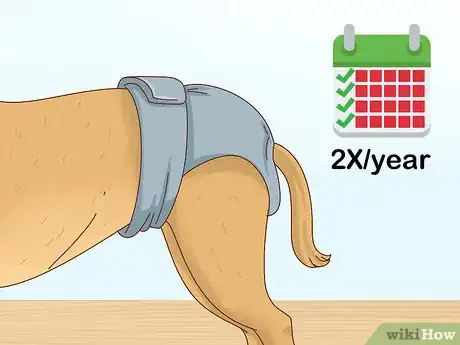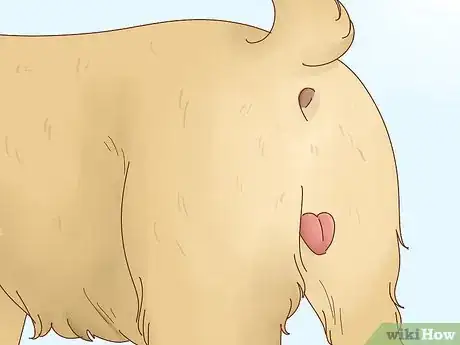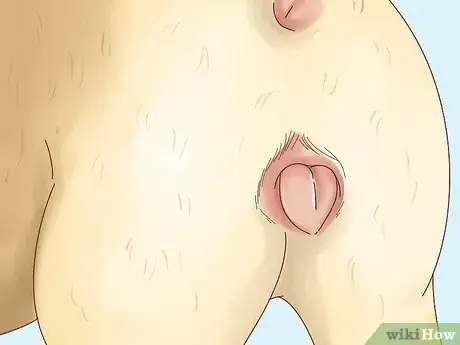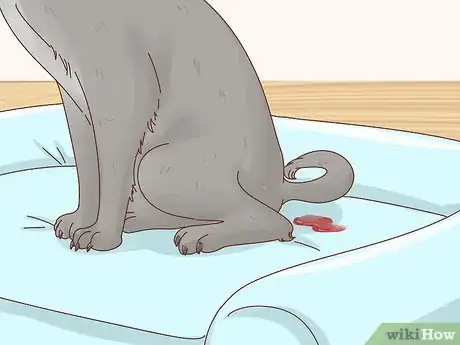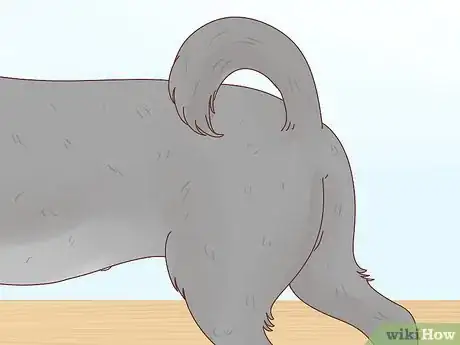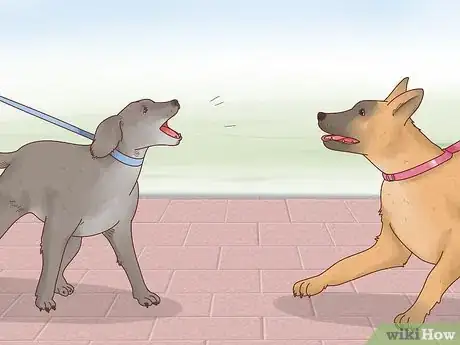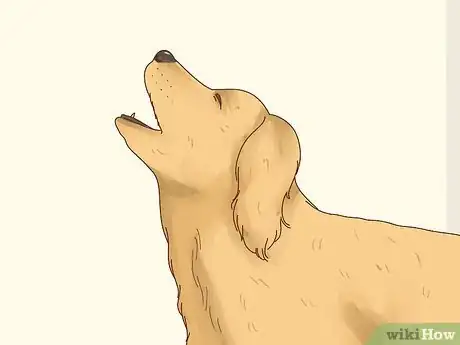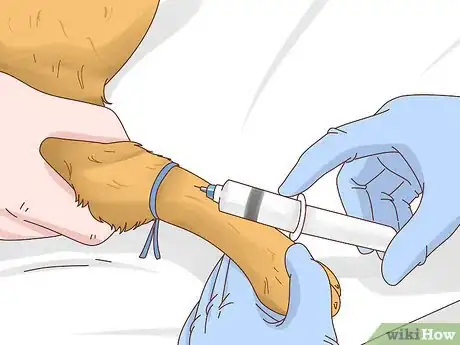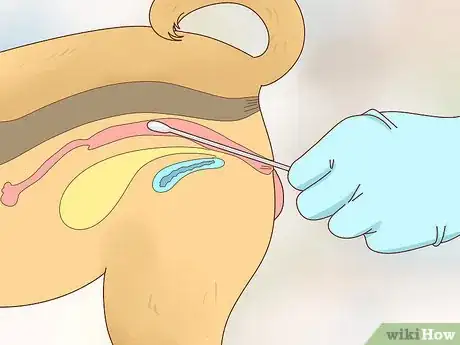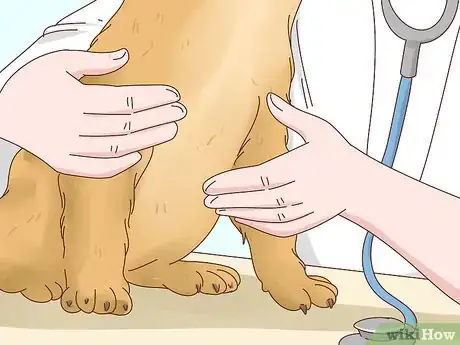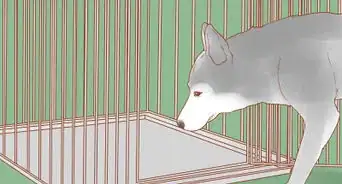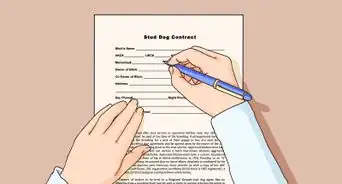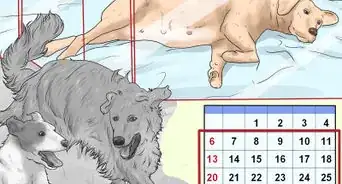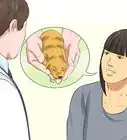This article was co-authored by Jamie Freyer, DVM. Dr. Jamie Freyer is a Licensed Doctor of Veterinary Medicine based in Washington. With over ten years of experience in clinical practice and industry, she specializes in veterinary medicine and surgery, animal behavior, and animal genetics. Dr. Freyer holds a BS in Life Science from The University of Portland and a DVM from Oregon State University.
There are 9 references cited in this article, which can be found at the bottom of the page.
wikiHow marks an article as reader-approved once it receives enough positive feedback. This article received 41 testimonials and 91% of readers who voted found it helpful, earning it our reader-approved status.
This article has been viewed 655,381 times.
Heat, which is also known as the estrus period, is a reproductive stage that unspayed female dogs go through. During this stage her eggs mature, making her fertile and able to produce puppies. Your dog will have different behavioral and physical changes during this stage, due to hormonal changes in her body. These changes will allow you to figure out whether she is in heat or not.
Steps
Understanding Estrus in Dogs
-
1Understand the basic reproductive cycle of your dog. When wondering if your dog is in heat, it first helps to understand her normal hormonal cycle. When a female dog reaches maturity, and is physically ready to reproduce, her estrogen levels increase, initiating the release of eggs from her ovaries. If mating occurs during this period, the eggs can then be fertilized and an embryo can be produced.[1]
- Female dogs, will generally go into heat during puberty, at around 6 to 24 months of age depending on breed. Smaller breeds generally come into heat earlier than larger breeds.
-
2Know when to check for signs of heat. In a year, a dog will usually go into heat twice with an average interval of six months in between each heat, depending on the breed.[2]
- This can help you decide if it's likely she's in heat. For example, if she was in heat one month ago, it's unlikely she's in heat again so soon and something might be wrong.
- While most dogs come into heat twice a year, is every six months, as with any hormonal event some dogs are more regular than others. Some dogs come into heat as regular as clockwork every six months, whilst others are highly variable. A window of 4 - 8 months is considered normal.
- Dogs are usually in heat for three to four weeks.
-
3Understand the signs of heat. The heat itself follows a pattern, with the vulva swelling and a bloody discharge in the first week. However, nature has a trick up her sleeve, because around days 7 - 14 the discharge may stop or become much lighter. This can trick the unwary owner into thinking season is over and their bitch is no longer at risk of pregnancy. However, nothing could be further from the truth. This middle week is actually when the dog ovulates, and is at the peak risk of falling pregnant.
- This is also the week when she is most interested in finding a boyfriend, and so far from relaxing your vigilance, if you do not want the dog to have puppies you should tighten up on security.
- Around days 14 - 21 into the heat, the bloody discharge returns, but gradually lightens and dries up completely. However, the vulva often remains larger than normal for another couple of weeks (although she cannot get pregnant now her heat is over).
Looking for Physical and Behavioral Signs Your Dog is in Heat
-
1
-
2Notice any vaginal bleeding.[5] Vaginal bleeding is a sign that your dog will soon be going into heat. [6] When your dog goes into heat, the amount of blood will decrease quite a bit and the blood will become brownish in color.
- If a dog is scrupulously clean and licks away the discharge, it can be tricky to know if a discharge is present or not. A useful tip is to cover her bed with a white sheet or pillowcase. That way when she is asleep you will see blood spots on the white cover.
- If you plan on breeding your dog, write down the day that the bleeding begins. Breeding is best done on the 10th or 11th day after the first day of bleeding and then every other day after that for three days.
-
3Notice whether your dog continuously licks herself.[7] Another sign that your dog is entering heat, or in its early stages, is if she constantly licks her vagina. While some female dogs won't do this, most dogs will develop this behavior right around the time that they go into heat.
-
4Take note if your dog starts acting strangely. [8] Dogs who are in the early stages of heat tend to develop behaviors that they do not typically display. In particular, female dogs who are about to go into heat are usually nervous, agitated, or easily irritated.[9]
- Some dogs will also bark more or become more aggressive with people and dogs around them.
-
5Pay attention to increased mating behaviors. If your female dog begins mounting male dogs or other dogs, she is more than likely in heat. Mounting is a common sign that a dog is in the full swing of heat. She may even try to mount your legs.
- However, dogs can mount legs or each other for behavioral reasons, such as masturbating, dominance, or bizarrely from submissive behavior, so this does not automatically mean a dog in heat.
-
6Watch for changes in the way your dog positions her tail. When a female dog enters heat, she will curl her tail to one side, making it easier for mating to occur. This action is called 'flagging' and is a common behavior of dog in heat.[10]
- You may also elicit this behavior by giving her a vigorous scratch on her rump. If she stiffens her back legs and diverts her tail to one side she is flagging.
- Never insert anything into the dog's vulva or vagina to test out if she is ready. You can inadvertently cause harm to the delicate, inflamed tissues and cause huge distress to her.
Noticing the Behavior of Male Dogs
-
1Know that some female dogs are 'silent heaters'. These dogs do not display any noticeable signs of being in heat. They produce reproductive hormones but don't develop the more usual external signs such as a swollen vulva.
- The only way you can really confirm if a silent heater is in heat is by observing the interactions between male dogs and the female dog in question. Male dogs will detect even low levels of female reproductive hormones, which will arouse their intense interest and attention.
- Be aware that some dogs do "skip" a heat. If they are unwell or their health is below par, or if they have lost weight recently, their body may save its energy and she won't come into heat when expected. This is nature's way of saying her body needs all its reserves to look after number one, rather than being in a state of flourishing good health where she could care for puppies.
-
2Pay attention to the levels of aggressiveness in male dogs. If you have a couple of male dogs, as well as your female dog who you think may be in heat, pay attention to how aggressive your male dogs are to one another. When more than one male dog is around a female in heat, they will begin to act very aggressively towards one another to prove who is dominant and should mate with the female dog.
-
3Notice an increase in verbal communication and agitation. If you own one male dog and a female dog that you think may be in heat, pay attention to how the male dog reacts to being kept apart from the female dog. If he seems more agitated than normal and whines frequently, he is most likely verbalizing his irritation and not being allowed near the female dog. This is a good indicator that your dog is in heat.
- Although this is not foolproof and you need to interpret this in the context of the dog's physical changes and the male dog's usual behavior when kept apart from his female pal. Some dogs experience anxiety when separated from a close playmate and this is difficult to differentiate from sexual frustration.
-
4Observe the interactions between your male dog and your female dog. If you let your dogs run around together all the time, then observe what happens when your male dog gets near your female dog. If your dog allows her vagina to be licked and sniffed for an extended period of time, she is most likely in heat. In particular, if she lets herself be mounted it is a sign that she is in heat.[11] [12]
- However, allowing another dog to mount her, can also be a sign of submissive behavior, so once again, you need to interpret the whole picture and ask questions such as is her heat due and how does she normally behave around dogs. Remember, sniffing bottoms is something dogs like to do a lot, at the best of times, just to work out who is who!
- If your male and female dogs don't normally interact, keep your male dog on a leash when you bring him near your female dog. One or both dogs may become aggressive if they are not familiar with each other.
Testing for Heat at the Veterinarian
-
1Have your veterinarian do a blood test to determine if your dog is in heat.[13] A test can be used that measures blood progesterone levels, which rise when the dog is in heat. This is simply done via a sample drawn from the bitch and sent to the lab. Low levels indicate she is not cycling, medium levels show she is in heat, and high levels indicate she is pregnant.
- The alternative is a test used in research establishments. It measures the level of Luteinizing hormone (LH) in the bloodstream, which rises prior to ovulation. However, this is not commercially available as a test kit.
-
2Have your veterinarian do a Vaginal Cytology test. It is quick and easy to do.[14] The veterinarian rolls a clean cotton tip over the moist lining of the vulva and then rolls the cotton tip over a glass microscope slide. Once the smear is dry, it is stained and examined under the microscope.
- A dog in heat has a typical pattern of large, cornified cells plus red blood cells that are typical of being in heat. This along with physical signs is enough to decide if the dog is in heat.
-
3Ask yourself whether the symptoms you are seeing could be heat or if they suggest a health problem. [15] This means it's important to use your common sense when wondering if the dog is in heat. If you are in any doubt, then take her to see your veterinarian.[16]
- Is the dog due to be in heat? If yes, then heat is more likely than a health problem.
- Was she recently in heat? If yes, then another heat is unlikely and there may be a health problem.
- Is she in good spirits, eating and drinking normally, and normally active? If yes, heat is more likely.
- Is she not quite herself, is her appetite reduced, is she more thirsty than usual, or does she keep vomiting? If yes, a health problem is likely and urgent veterinary attention sought.
-
4Have your veterinarian take a look at your dog if she should not be in heat but is exhibiting similar symptoms. There is a health condition, pyometra, that affects older dogs which, to the untrained eye, could mimic being in heat. The overlapping symptoms include a swollen vulva, with or without a vaginal discharge. A pyometra refers to a womb infection. In severe cases the womb fills with pus and the dog becomes toxic when toxins from the bacteria are absorbed into the bloodstream.
- If you have an older dog, who has recently been in heat (4 - 8 weeks before) and she develops a discharge, seek veterinary attention because this is the peak risk period for a pyometra developing.
- In the early stages the dog may be more thirsty or lack a good appetite. As the condition becomes more serious, the toxins causes kidney damage, and left untreated, can be fatal.
- Each time the dog has a heat it weakens the lining of the womb slightly and makes a pyometra more likely. This condition mainly affects aging dogs (the more cycles she has, the more likely it is to happen) and no breed is exempt from being at risk.
Expert Q&A
-
QuestionDo female dogs act differently when in heat?
 Jamie Freyer, DVMDr. Jamie Freyer is a Licensed Doctor of Veterinary Medicine based in Washington. With over ten years of experience in clinical practice and industry, she specializes in veterinary medicine and surgery, animal behavior, and animal genetics. Dr. Freyer holds a BS in Life Science from The University of Portland and a DVM from Oregon State University.
Jamie Freyer, DVMDr. Jamie Freyer is a Licensed Doctor of Veterinary Medicine based in Washington. With over ten years of experience in clinical practice and industry, she specializes in veterinary medicine and surgery, animal behavior, and animal genetics. Dr. Freyer holds a BS in Life Science from The University of Portland and a DVM from Oregon State University.
Licensed Veterinarian They definitely can! For instance, a dog in heat might be more lenient if another dog tries to mount her.
They definitely can! For instance, a dog in heat might be more lenient if another dog tries to mount her. -
QuestionWhat do I do when my dog is bleeding in heat?
 Jamie Freyer, DVMDr. Jamie Freyer is a Licensed Doctor of Veterinary Medicine based in Washington. With over ten years of experience in clinical practice and industry, she specializes in veterinary medicine and surgery, animal behavior, and animal genetics. Dr. Freyer holds a BS in Life Science from The University of Portland and a DVM from Oregon State University.
Jamie Freyer, DVMDr. Jamie Freyer is a Licensed Doctor of Veterinary Medicine based in Washington. With over ten years of experience in clinical practice and industry, she specializes in veterinary medicine and surgery, animal behavior, and animal genetics. Dr. Freyer holds a BS in Life Science from The University of Portland and a DVM from Oregon State University.
Licensed Veterinarian Don't worry—that's normal. You might notice some blood while your dog is heat, and she might be licking and cleaning herself in that area a lot.
Don't worry—that's normal. You might notice some blood while your dog is heat, and she might be licking and cleaning herself in that area a lot. -
QuestionHow do you care for a dog in heat?
 Lauren NovackLauren Novack is a Certified Dog Behavior Consultant at Behavior Vets NYC where she helps fearful, anxious, and aggressive pets and their owners. She has completed coursework for her MS in Applied Behavior Analysis at Hunter College. Lauren’s research explores the intersection between training practices and animal welfare. She currently serves on the Editorial Advisory Board for Daily Paws and has appeared on Fox & Friends, Rachel Ray, and various news outlets with her dog Grayson.
Lauren NovackLauren Novack is a Certified Dog Behavior Consultant at Behavior Vets NYC where she helps fearful, anxious, and aggressive pets and their owners. She has completed coursework for her MS in Applied Behavior Analysis at Hunter College. Lauren’s research explores the intersection between training practices and animal welfare. She currently serves on the Editorial Advisory Board for Daily Paws and has appeared on Fox & Friends, Rachel Ray, and various news outlets with her dog Grayson.
Certified Dog Behavior Consultant Before your dog goes into heat, talk to your veterinarian about what to expect and what to prepare. You will see behavioral changes in your pup before they start bleeding. Some dogs will want more space, others become very clingy. Unless they ask to be pet, it may be best to not touch them. Use the three-second rule. Pet them for three seconds and then stop. If your dog doesn’t actively ask for more pets by nudging or pawing you, keep your hands to yourself. When you see the behavior changes it’s also time to run out and get doggy diapers if you haven’t already stocked up. You’ll also need to keep male dogs away from your pup to prevent pregnancy. It’s time to walk your pup on leash only - no dog parks or off leash hikes.
Before your dog goes into heat, talk to your veterinarian about what to expect and what to prepare. You will see behavioral changes in your pup before they start bleeding. Some dogs will want more space, others become very clingy. Unless they ask to be pet, it may be best to not touch them. Use the three-second rule. Pet them for three seconds and then stop. If your dog doesn’t actively ask for more pets by nudging or pawing you, keep your hands to yourself. When you see the behavior changes it’s also time to run out and get doggy diapers if you haven’t already stocked up. You’ll also need to keep male dogs away from your pup to prevent pregnancy. It’s time to walk your pup on leash only - no dog parks or off leash hikes.
Warnings
- If you have already spayed your dog and find that she has the bloody discharge that is generally associated with being in heat, bring her to the vet. She may have a urinary tract infection, a venereal disease like a transmissible venereal tumor (TVT), wounds, trauma, or a uterine infection.⧼thumbs_response⧽
References
- ↑ https://www.aspca.org/pet-care/dog-care/estrus-or-heat
- ↑ http://pets.webmd.com/dogs/how-tell-if-dogs-heat
- ↑ Jamie Freyer, DVM. Licensed Veterinarian. Expert Interview. 8 October 2021.
- ↑ http://www.banfield.com/pet-health-resources/pet-health-concerns/reproduction/is-my-dog-in-heat
- ↑ Jamie Freyer, DVM. Licensed Veterinarian. Expert Interview. 8 October 2021.
- ↑ Lauren Baker, DVM, PhD. Veterinarian. Expert Interview. 29 May 2019.
- ↑ Jamie Freyer, DVM. Licensed Veterinarian. Expert Interview. 8 October 2021.
- ↑ Lauren Baker, DVM, PhD. Veterinarian. Expert Interview. 29 May 2019.
- ↑ http://www.banfield.com/pet-health-resources/pet-health-concerns/reproduction/is-my-dog-in-heat
- ↑ http://pets.webmd.com/dogs/how-tell-if-dogs-heat
- ↑ http://www.pets.ca/dogs/tips/tip-57-dog-in-heat-signs-your-dog-is-in-heat-the-estrous-cycle/
- ↑ Jamie Freyer, DVM. Licensed Veterinarian. Expert Interview. 8 October 2021.
- ↑ Evaluation of the ICAGEN-Target canine ovulation timing diagnostic test in detecting canine plasma progesterone concentrations. Manothaiudom, Johnston, Hegstad. JAAHA 31 (1) 57-64
- ↑ Reproduction in the dog and cat. Christiansen. Publisher: Bailliere-Tindal.
- ↑ Small Animal Internal Medicine. Nelson & Couto. Publisher: Mosby
- ↑ Lauren Baker, DVM, PhD. Veterinarian. Expert Interview. 29 May 2019.
About This Article
To tell if your dog is in heat, look for swelling of its vulva or vaginal bleeding, which are both early signs. Also, note any strange behavior that your dog is exhibiting, like increased barking, nervousness, or agitation, since dogs that are in heat will often act differently than they usually do. If you notice your dog attempting to mount other dogs more frequently, or if you notice its tail curled to one side, it could mean that it's in heat. To learn how to have your dog tested by a vet to determine if it's in heat, scroll down!

